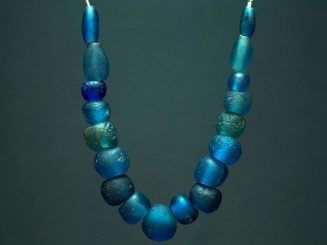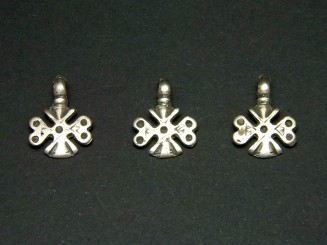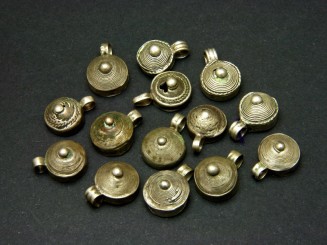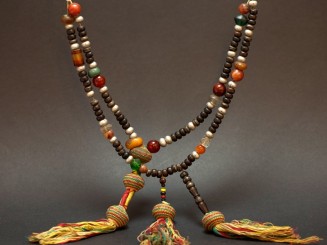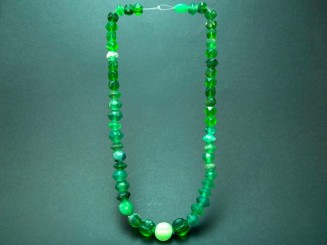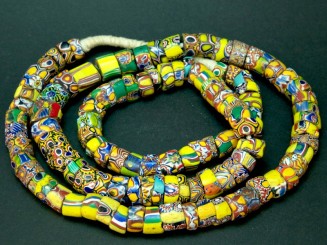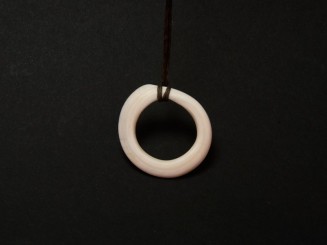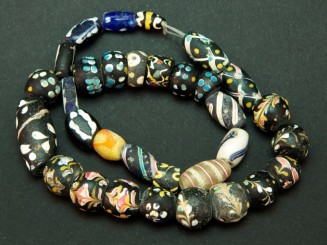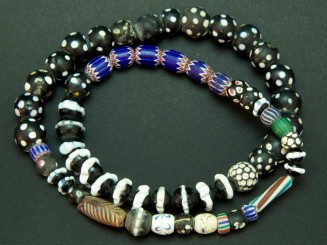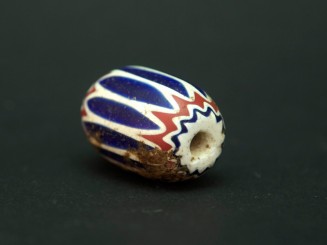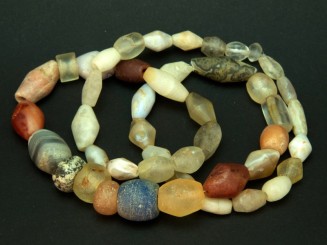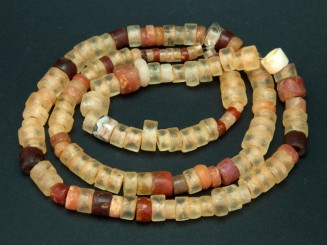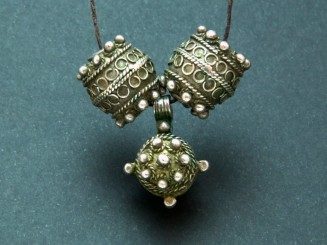
Jewels
-
Price €275.00MD1115-415
This is a great set of ten antique Islamic glass eye lamp work beads sourced in Mali in the region south of the Niger river between the cities of Mopti and Gao. Though they have been buried for hundreds of years they show a nice condition and a wonderful patina. Their colors range from different shades of blue from dark blue (almost black) to aquamarine. Some of them show some band decoration which adds to their appeal.
The dimensions range from a diameter of 17 mm for the larger bead to 12mm for the smaller one.
When referring to Islamic beads we follow bead expert Robert K. Liu’s description in Ornament Magazine: “The term Islamic Period Glass Beads is used, similarly to Roman Period Beads, to classify groups of ornaments from specific geographic areas and time periods, with recognizable characteristics including patterns and techniques. In the case of Islamic glass beads we know they originated in the Middle East and flourished mostly between the seventh and twelfth centuries. Their designs display a wide mix of techniques and styles: millefiori/mosaic (including pierced mosaic pad beads), trailed, filigreed, combed, fused rods, segmented/blown, folded (an Islamic innovation, Holland and Holland 2006) and those derived from amulet shapes, like charmcase beads with loops.” Islamic glass beads travelled from their sources of production in the Middle and Near East together with the expansion of Islam to North Africa, Southern Europe (Spain), India and the Far East and they reached areas well beyond Islam’s actual limits of expansion such as Northern Europe. They also flowed into Sub-Saharan Africa, where they were valued and cherished for centuries in the Malian ancient kingdoms as a symbol of status and played an important role in the communities’ rites and ceremonies such a burials, initiation or dowries.
Eye glass beads are beads which main feature are circular decorations that remind of an eye made using lamp work, inset or mosaic techniques. One of the best examples of eye beads are found among Islamic beads mostly blue or green with white eyes as well as eye dotted Venetian glass beads (skunk). The eye decoration may be a simple eye or a number of them scattered on the surface of the bead, they may be plain ones or concentric ones using different colors. Eye beads may also present some linear trails, ziz-zag or floral decoration. Eye beads have been very much valued for centuries, actually they still are, among not only Islamic people but also African people as they were regarded as strong amulets to avert the evil eye and for their alleged prophylactic and magical properties.
-
Price €95.00MD1114-385
A great set of antique Islamic translucent glass beads from the medieval ages in nice shades of blue color. They show a great condition regardless of the fact that they have remained buried for hundreds of years. Found in Mali in the region south of the Niger river between the cities of Mopti and Gao. Fourteen of them are round in shape and the remaining oval. Quite similar beads to the latter have been found in fortresses of the Bizantine period in Albania.
The central bead has a diameter of 15mm and the smaller’s is 8mm.
When referring to Islamic beads we follow bead expert Robert K. Liu’s description in Ornament Magazine: “The term Islamic Period Glass Beads is used, similarly to Roman Period Beads, to classify groups of ornaments from specific geographic areas and time periods, with recognizable characteristics including patterns and techniques. In the case of Islamic glass beads we know they originated in the Middle East and flourished mostly between the seventh and twelfth centuries. Their designs display a wide mix of techniques and styles: millefiori/mosaic (including pierced mosaic pad beads), trailed, filigreed, combed, fused rods, segmented/blown, folded (an Islamic innovation, Holland and Holland 2006) and those derived from amulet shapes, like charmcase beads with loops.” Islamic glass beads travelled from their sources of production in the Middle and Near East together with the expansion of Islam to North Africa, Southern Europe (Spain), India and the Far East and they reached areas well beyond Islam’s actual limits of expansion such as Northern Europe. They also flowed into Sub-Saharan Africa, where they were valued and cherished for centuries in the Malian ancient kingdoms as a symbol of status and played an important role in the communities’ rites and ceremonies such a burials, initiation or dowries.
-
Price €105.00MD1114-384
A great set of thirteen antique Islamic glass eye lamp work beads sourced in Mali in the region south of the Niger river between the cities of Mopti and Gao. They have been buried for hundreds of years which has given them a wonderful patina and distressed appearance adding to their allure. They show a beautiful traslucent blue color.
The diameter of the larger bead is 17 mm and the smaller’s is 13mm.
When referring to Islamic beads we follow bead expert Robert K. Liu’s description in Ornament Magazine: “The term Islamic Period Glass Beads is used, similarly to Roman Period Beads, to classify groups of ornaments from specific geographic areas and time periods, with recognizable characteristics including patterns and techniques. In the case of Islamic glass beads we know they originated in the Middle East and flourished mostly between the seventh and twelfth centuries. Their designs display a wide mix of techniques and styles: millefiori/mosaic (including pierced mosaic pad beads), trailed, filigreed, combed, fused rods, segmented/blown, folded (an Islamic innovation, Holland and Holland 2006) and those derived from amulet shapes, like charmcase beads with loops.” Islamic glass beads travelled from their sources of production in the Middle and Near East together with the expansion of Islam to North Africa, Southern Europe (Spain), India and the Far East and they reached areas well beyond Islam’s actual limits of expansion such as Northern Europe. They also flowed into Sub-Saharan Africa, where they were valued and cherished for centuries in the Malian ancient kingdoms as a symbol of status and played an important role in the communities’ rites and ceremonies such a burials, initiation or dowries.
-
Price €135.00MD1114-383
This is an outstanding set of twenty-five antique Islamic glass eye lamp work beads sourced in Mali in the region south of the Niger river between the cities of Mopti and Gao. They have been buried for hundreds of years which has given them a wonderful patina and the fact that most of the “eyes” have been lost that has indeed added to their character. Their colors range from different shades of blue from dark blue (almost black) to aquamarine.
The main bead has a diameter of 13mm whilst the smaller’s is 10mm.
When referring to Islamic beads we follow bead expert Robert K. Liu’s description in Ornament Magazine: “The term Islamic Period Glass Beads is used, similarly to Roman Period Beads, to classify groups of ornaments from specific geographic areas and time periods, with recognizable characteristics including patterns and techniques. In the case of Islamic glass beads we know they originated in the Middle East and flourished mostly between the seventh and twelfth centuries. Their designs display a wide mix of techniques and styles: millefiori/mosaic (including pierced mosaic pad beads), trailed, filigreed, combed, fused rods, segmented/blown, folded (an Islamic innovation, Holland and Holland 2006) and those derived from amulet shapes, like charmcase beads with loops.” Islamic glass beads travelled from their sources of production in the Middle and Near East together with the expansion of Islam to North Africa, Southern Europe (Spain), India and the Far East and they reached areas well beyond Islam’s actual limits of expansion such as Northern Europe. They also flowed into Sub-Saharan Africa, where they were valued and cherished for centuries in the Malian ancient kingdoms as a symbol of status and played an important role in the communities’ rites and ceremonies such a burials, initiation or dowries.
Eye glass beads are beads which main feature are circular decorations that remind of an eye made using lamp work, inset or mosaic techniques. One of the best examples of eye beads are found among Islamic beads mostly blue or green with white eyes as well as eye dotted Venetian glass beads (skunk). The eye decoration may be a simple eye or a number of them scattered on the surface of the bead, they may be plain ones or concentric ones using different colors. Eye beads may also present some linear trails, ziz-zag or floral decoration. Eye beads have been very much valued for centuries, actually they still are, among not only Islamic people but also African people as they were regarded as strong amulets to avert the evil eye and for their alleged prophylactic and magical properties.
-
Price €75.00MD0316-302
A charming set of seven lamp work Venetian fiorà trade beads from the first half of the XIXth century. Their name comes from their characteristic floral or flower decoration that in a captivating array of colors (green, yelow, white -lattimo) and motifs is distributed on the main body of the bead which, in this particular case, is of a nice opaque black color.
Approximate measures (larger bead): 12mm x 12mm.
Also referred to as decorated fancy beads, fiorate or fiorà, these Venetian lamp work glass trade beads are amongst the most attractive we may find. Their main feature is their flamboyant and joyful floral or flower decoration using a rich variety of colors and patterns: feather, bow tie, bouquet, dots, spiral (here we have to mention the well-known Lewis & Clark beads named after the explorers who first traded them with the tribes they found on their expedition from the East to the West coast of the United States in the early 1800s), linear, filigree, etc. They were mainly produced as from the first half of the 19th century. They are usually round or oval shaped.
We use the term trade beads to refer to the European made glass beads that were used by the European merchants and explorers in the trade in Africa as from the 15th century and continued during their colonial expansion.The history of trade beads in Africa takes us then to the 15th century and the arrival of the European, mainly the Portuguese, to the coasts of West Africa. The European discovered quite soon how much the people they met there fancied beads and saw they an opportunity for trade. Amongst the beads that captivated the African people most were glass beads since the techniques for their making had not yet been developed locally. The locals fell for the precious and colorful glass beads such as Venetian millefiori or chevron beads that the European traders had on offer and bartered them for commodities such as precious woods, ivory, gold and even used, ignominiously, in the slave trade. The increasing demand in Africa of European made glass beads continued quite until the first half of the 20th century and it had a boosting effect in the production in cities such as Venice which glass beads became very popular and coveted.
-
Price €42.00MD0316-301
A set of four joyful lamp work Venetian fiorà trade beads from the first half of the XIXth century. Their name comes from their characteristic floral or flower decoration that in a captivating array of colors and motifs is distributed on the main body of the bead which, in this particular case, is of a nice opaque black color.
Approximate dimensions (larger bead): 12mm x 12mm.
Also referred to as decorated fancy beads, fiorate or fiorà, these Venetian lamp work glass trade beads are amongst the most attractive we may find. Their main feature is their flamboyant and joyful floral or flower decoration using a rich variety of colors and patterns: feather, bow tie, bouquet, dots, spiral (here we have to mention the well-known Lewis & Clark beads named after the explorers who first traded them with the tribes they found on their expedition from the East to the West coast of the United States in the early 1800s), linear, filigree, etc. They were mainly produced as from the first half of the 19th century. They are usually round or oval shaped.
We use the term trade beads to refer to the European made glass beads that were used by the European merchants and explorers in the trade in Africa as from the 15th century and continued during their colonial expansion.The history of trade beads in Africa takes us then to the 15th century and the arrival of the European, mainly the Portuguese, to the coasts of West Africa. The European discovered quite soon how much the people they met there fancied beads and saw they an opportunity for trade. Amongst the beads that captivated the African people most were glass beads since the techniques for their making had not yet been developed locally. The locals fell for the precious and colorful glass beads such as Venetian millefiori or chevron beads that the European traders had on offer and bartered them for commodities such as precious woods, ivory, gold and even used, ignominiously, in the slave trade. The increasing demand in Africa of European made glass beads continued quite until the first half of the 20th century and it had a boosting effect in the production in cities such as Venice which glass beads became very popular and coveted.
-
Price €55.00MD0316-300
A set of six fantastic lamp work Venetian fiorà trade beads from the first half of the XIXth century. Their name comes from their characteristic floral or flower decoration that in a captivating array of colors and motifs is distributed on the main body of the bead which, in this particular case, is of a nice opaque black color. Lovely wear.
Approximate measures (larger bead): 12mm x 12mm.
Also referred to as decorated fancy beads, fiorate or fiorà, these Venetian lamp work glass trade beads are amongst the most attractive we may find. Their main feature is their flamboyant and joyful floral or flower decoration using a rich variety of colors and patterns: feather, bow tie, bouquet, dots, spiral (here we have to mention the well-known Lewis & Clark beads named after the explorers who first traded them with the tribes they found on their expedition from the East to the West coast of the United States in the early 1800s), linear, filigree, etc. They were mainly produced as from the first half of the 19th century. They are usually round or oval shaped.
We use the term trade beads to refer to the European made glass beads that were used by the European merchants and explorers in the trade in Africa as from the 15th century and continued during their colonial expansion.The history of trade beads in Africa takes us then to the 15th century and the arrival of the European, mainly the Portuguese, to the coasts of West Africa. The European discovered quite soon how much the people they met there fancied beads and saw they an opportunity for trade. Amongst the beads that captivated the African people most were glass beads since the techniques for their making had not yet been developed locally. The locals fell for the precious and colorful glass beads such as Venetian millefiori or chevron beads that the European traders had on offer and bartered them for commodities such as precious woods, ivory, gold and even used, ignominiously, in the slave trade. The increasing demand in Africa of European made glass beads continued quite until the first half of the 20th century and it had a boosting effect in the production in cities such as Venice which glass beads became very popular and coveted.
-
Price €65.00MD0316-298
Funky!. This is the word that comes first to our mind when admiring this great set of five lovely lamp work Venetian fiorà trade beads from the first half of the XIXth century. Their name comes from their characteristic floral or flower decoration that in a superb combination of colors and motifs is distributed on the main body of the bead which, in this particular case, is of a nice opaque black color. The central bead also shows a central band in aventurine which gives it a glittering mettallic effect.
Approximate dimensions (central bead): 12mm x 12mm.
Also referred to as decorated fancy beads, fiorate or fiorà, these Venetian lamp work glass trade beads are amongst the most attractive we may find. Their main feature is their flamboyant and joyful floral or flower decoration using a rich variety of colors and patterns: feather, bow tie, bouquet, dots, spiral (here we have to mention the well-known Lewis & Clark beads named after the explorers who first traded them with the tribes they found on their expedition from the East to the West coast of the United States in the early 1800s), linear, filigree, etc. They were mainly produced as from the first half of the 19th century. They are usually round or oval shaped.
We use the term trade beads to refer to the European made glass beads that were used by the European merchants and explorers in the trade in Africa as from the 15th century and continued during their colonial expansion.The history of trade beads in Africa takes us then to the 15th century and the arrival of the European, mainly the Portuguese, to the coasts of West Africa. The European discovered quite soon how much the people they met there fancied beads and saw they an opportunity for trade. Amongst the beads that captivated the African people most were glass beads since the techniques for their making had not yet been developed locally. The locals fell for the precious and colorful glass beads such as Venetian millefiori or chevron beads that the European traders had on offer and bartered them for commodities such as precious woods, ivory, gold and even used, ignominiously, in the slave trade. The increasing demand in Africa of European made glass beads continued quite until the first half of the 20th century and it had a boosting effect in the production in cities such as Venice which glass beads became very popular and coveted.
Aventurine refers to a caramel or brown coloured glass paste with a captivating metallic reflection used to decorate European trade glass beads and which, apparently, was only discovered by accident in the early 17th century.
-
Price €75.00MD0316-297
We can think of Alice wandering Wonderland wearing a necklace made of a combination of these awesome glass beads. This is a set of seven superb lamp work Venetian fiorà trade beads from the first half of the XIXth century. Their name comes from their characteristic floral or flower decoration that in a captivating array of colors (pink, yellow, white-lattimo) and motifs is distributed on the main body of the bead which, in this particular case, is of a nice dark green color.
Approximate measures (larger bead): 12mm x 14mm.
Also referred to as decorated fancy beads, fiorate or fiorà, these Venetian lamp work glass trade beads are amongst the most attractive we may find. Their main feature is their flamboyant and joyful floral or flower decoration using a rich variety of colors and patterns: feather, bow tie, bouquet, dots, spiral (here we have to mention the well-known Lewis & Clark beads named after the explorers who first traded them with the tribes they found on their expedition from the East to the West coast of the United States in the early 1800s), linear, filigree, etc. They were mainly produced as from the first half of the 19th century. They are usually round or oval shaped.
We use the term trade beads to refer to the European made glass beads that were used by the European merchants and explorers in the trade in Africa as from the 15th century and continued during their colonial expansion.The history of trade beads in Africa takes us then to the 15th century and the arrival of the European, mainly the Portuguese, to the coasts of West Africa. The European discovered quite soon how much the people they met there fancied beads and saw they an opportunity for trade. Amongst the beads that captivated the African people most were glass beads since the techniques for their making had not yet been developed locally. The locals fell for the precious and colorful glass beads such as Venetian millefiori or chevron beads that the European traders had on offer and bartered them for commodities such as precious woods, ivory, gold and even used, ignominiously, in the slave trade. The increasing demand in Africa of European made glass beads continued quite until the first half of the 20th century and it had a boosting effect in the production in cities such as Venice which glass beads became very popular and coveted.
-
Price €75.00MD0316-296
Oh my!. They are so sweet that we cannot but think of candy. A great set of seven eye-catching lamp work Venetian fiorà trade beads from the first half of the XIXth century. Their name comes from their characteristic floral or flower decoration that in a captivating array of colors and motifs is distributed on the main body of the bead which, in this particular case, is of a nice translucent red color which allows to see the main white core of the beads (white hearts).
Approximate measures (central bead). 11mm x 13mm.
Also referred to as decorated fancy beads, fiorate or fiorà, these Venetian lamp work glass trade beads are amongst the most attractive we may find. Their main feature is their flamboyant and joyful floral or flower decoration using a rich variety of colors and patterns: feather, bow tie, bouquet, dots, spiral (here we have to mention the well-known Lewis & Clark beads named after the explorers who first traded them with the tribes they found on their expedition from the East to the West coast of the United States in the early 1800s), linear, filigree, etc. They were mainly produced as from the first half of the 19th century. They are usually round or oval shaped.
We use the term trade beads to refer to the European made glass beads that were used by the European merchants and explorers in the trade in Africa as from the 15th century and continued during their colonial expansion.The history of trade beads in Africa takes us then to the 15th century and the arrival of the European, mainly the Portuguese, to the coasts of West Africa. The European discovered quite soon how much the people they met there fancied beads and saw they an opportunity for trade. Amongst the beads that captivated the African people most were glass beads since the techniques for their making had not yet been developed locally. The locals fell for the precious and colorful glass beads such as Venetian millefiori or chevron beads that the European traders had on offer and bartered them for commodities such as precious woods, ivory, gold and even used, ignominiously, in the slave trade. The increasing demand in Africa of European made glass beads continued quite until the first half of the 20th century and it had a boosting effect in the production in cities such as Venice which glass beads became very popular and coveted.
-
Price €130.00MA1015-382
A superb set of thirty-five antique Venetian glass trade beads from the begginning of the XIXth century. Very distintictive white swirls decoration on a black body. They are commonly referred in the trade as tire beads due to their shape and rattesnake beads as their decoration somewhat reminds of the rattle of those snakes. They are quite difficult to find, particularly the two ones showing a broad bright yellow stripe and a narrower middle red one. Approximate dimensions (larger one): length: 11mm, diameter 14mm.
We use the term trade beads to refer to the European made glass beads that were used by the European merchants and explorers in the trade in Africa as from the 15th century and continued during their colonial expansion. The history of trade beads in Africa takes us then to the 15th century and the arrival of the European, mainly the Portuguese, to the coasts of West Africa. The European discovered quite soon how much the people they met there fancied beads and saw they an opportunity for trade. Amongst the beads that captivated the African people most were glass beads since the techniques for their making had not yet been developed locally. The locals fell for the precious and colorful glass beads such as Venetian millefiori or chevron beads that the European traders had on offer and bartered them for commodities such as precious woods, ivory, gold and even used, ignominiously, in the slave trade. The increasing demand in Africa of European made glass beads continued quite until the first half of the 20th century and it had a boosting effect in the production in cities such as Venice which glass beads became very popular and coveted.
Lamp working is one of the main techniques for the making of glass beads. Lamp or lamp work beads were made using glass canes that were reheated to a temperature of up to 1000 ºC by means of a blowtorch or blowlamp and which were then wound onto a coated iron rod to avoid the molten glass from sticking to the metal. The beads produced by the artisan by these means could be then further decorated by re-heating the bead using the same lamp work method and applying colored glass rods or glass cane inserts to the surface of the bead creating an endless variation of patterns and making of each bead one of its own.
-
Price €150.00MA1015-381
A great set of forty-eight antique Venetian lamp work glass barrel shaped trade beads from the late 1800s. The main body of the beads is of a opaque black color and it is decorated with longitudinal white stripes. This type of beads is quite are and when found quite often it is just a few of them. These we were fotunate enough to source them in Mauritania.
Approximate dimensions: length: 12mm, diameter 8mm.
We use the term trade beads to refer to the European made glass beads that were used by the European merchants and explorers in the trade in Africa as from the 15th century and continued during their colonial expansion. The history of trade beads in Africa takes us then to the 15th century and the arrival of the European, mainly the Portuguese, to the coasts of West Africa. The European discovered quite soon how much the people they met there fancied beads and saw they an opportunity for trade. Amongst the beads that captivated the African people most were glass beads since the techniques for their making had not yet been developed locally. The locals fell for the precious and colorful glass beads such as Venetian millefiori or chevron beads that the European traders had on offer and bartered them for commodities such as precious woods, ivory, gold and even used, ignominiously, in the slave trade. The increasing demand in Africa of European made glass beads continued quite until the first half of the 20th century and it had a boosting effect in the production in cities such as Venice which glass beads became very popular and coveted.
Lamp working is one of the main techniques for the making of glass beads. Lamp or lamp work beads were made using glass canes that were reheated to a temperature of up to 1000 ºC by means of a blowtorch or blowlamp and which were then wound onto a coated iron rod to avoid the molten glass from sticking to the metal. The beads produced by the artisan by these means could be then further decorated by re-heating the bead using the same lamp work method and applying colored glass rods or glass cane inserts to the surface of the bead creating an endless variation of patterns and making of each bead one of its own.
-
Price €28.00MA0400-794
Set of 3 Great old silver pendants or beads from Southern Morocco and further south Saharan areas. Very original.
-
Price €65.00ET0310-306
A great assortment of 14 antique Ethipian amulet-beads or -telsum-. They are made of silver alloy and feature a beautiful patina. They would protect their wearer against evil eye and ward off any other evil influences.
-
Price €55.00ET0310-305
A great assortment of 11 antique Ethipian amulet-beads or -telsum-. They are made of silver alloy and feature a beautiful patina. They would protect their wearer against evil eye and ward off any other evil influences.Different sizes.
-
Price €22.00ET0310-304
Three antique Ethipian amulet-beads or -telsum-. They are made of silver alloy and feature a beautiful patina.They would protect their wearer against evil eye and ward off any other evil influences.
-
Price €64.00ET0310-131
A great assortment of 12 antique Ethipian amulet-beads or -telsum-. They are made of silver alloy and feature a beautiful patina. They would protect their wearer against evil eye and ward off any other evil influences.
-
Price €120.00MA0116-616
A rosary "tisbeh" from Mauritania. It is formed by a strand of old black ebony beads (some of them with silver filigree) and aluminium, and some others old glass beads of different sizes, types and colours and three true amber beads. The "tisbeh" is also decorated with three cotton tassels. Other names: "tasbih", "sebha", "mishat", "subhan"
-
Price €265.00MD1114-031
A beautiful strand of sixty five antique African trade glass beads in blue range color. Fantastic.
Beads have fascinated men all over the world for thousands of years. From the simplest ones made of clay, bone or horn to those made of metal, amber or glass or the most luxurious ones using precious stones and metals and where the result may sometimes be true pieces of art. Phoenicia, India, China, Rome, Tibet, Egypt, Mali, the Middle East, Mauritania, Venice, Persia, South America. You name it. Africa is not an exception to this. For centuries beads were used in Africa not only as pieces of adornment or status but, in many cases, as currency to trade a vast array of commodities (gold, ivory, exotic wood, etc.). Europe supplied the continent for hundreds of years with beads made in Murano, Bohemia, Germany, etc that mixed with those produced locally and others coming from lands farther beyond. All these beads, their awesome variety of designs, shapes, qualities, techniques, colors, material and origins have created a fascinating world that still subsists today and where we are not only captivated by what meets our eyes but also by the long and amazing history behind.
-
Price €95.00MD1114-026
Beads have fascinated men all over the world for thousands of years. From the simplest ones made of clay, bone or horn to those made of metal, amber or glass or the most luxurious ones using precious stones and metals and where the result may sometimes be true pieces of art. Phoenicia, India, China, Rome, Tibet, Egypt, Mali, the Middle East, Mauritania, Venice, Persia, South America. You name it. Africa is not an exception to this. For centuries beads were used in Africa not only as pieces of adornment or status but, in many cases, as currency to trade a vast array of commodities (gold, ivory, exotic wood, etc.). Europe supplied the continent for hundreds of years with beads made in Murano, Bohemia, Germany, etc that mixed with those produced locally and others coming from lands farther beyond. All these beads, their awesome variety of designs, shapes, qualities, techniques, colors, material and origins have created a fascinating world that still subsists today and where we are not only captivated by what meets our eyes but also by the long and amazing history behind.
Here we have now a marvelous strand of 59 old African glass trade beads from Europe, most likely Venice, known as black and white skunk beads.
-
Price €75.00MD0315-778
A beautiful set of old Bohemian glass “vaseline” beads sourced in Mali.Beads have fascinated men all over the world for thousands of years. From the simplest ones made of clay, bone or horn to those made of metal, amber or glass or the most luxurious ones using precious stones and metals and where the result may sometimes be true pieces of art. Phoenicia, India, China, Rome, Tibet, Egypt, Mali, the Middle East, Mauritania, Venice, Persia, South America. You name it. Africa is not an exception to this. For centuries beads were used in Africa not only as pieces of adornment or status but, in many cases, as currency to trade a vast array of commodities (gold, ivory, exotic wood, etc.). Europe supplied the continent for hundreds of years with beads made in Murano, Bohemia, Germany, etc that mixed with those produced locally and others coming from lands farther beyond. All these beads, their awesome variety of designs, shapes, qualities, techniques, colors, material and origins have created a fascinating world that still subsists today and where we are not only captivated by what meets our eyes but also by the long and amazing history behind.
-
Price €210.00MA0315-666
A superb strand of mixed old Murano glass beads, among them, the so-called millefiori (lit. thousand flowers) and mosaic. European glass trade beads became extremely popular in Africa. They were commonly used in barter transactions in exchange for a wide range of commodities from ivory or palm oil to gold. Venetian glass trade beads were among the most reputed ones both for the mastery in their manufacture as well as for the nearly endless combination of designs and colors. About the end of the XVth century most of the production of Venetian glass beads moved to the island of Murano were the drawn technique was recovered so that boosting the production as compared to the slower wound technique. Some other techniques were also used: molded, blown, wound-on-drawn. Some chips and dents commensurate with age. A beautiful combination of trade beads.
-
Price €150.00MA0315-668
A beautiful strand of mixed old Murano glass beads, among them, the so-called millefiori (lit. thousand flowers), mosaic and chevron. European glass trade beads became extremely popular in Africa. They were commonly used in barter transactions in exchange for a wide range of commodities from ivory or palm oil to gold. Venetian glass trade beads were among the most reputed ones both for the mastery in their manufacture as well as for the nearly endless combination of designs and colors. About the end of the XVth century most of the production of Venetian glass beads moved to the island of Murano were the drawn technique was recovered so that boosting the production as compared to the slower wound technique. Some other techniques were also used: molded, blown, wound-on-drawn. Some chips and dents commensurate with age. A beautiful combination of trade beads.
-
Price €9.00MD0514-004
Shells, and particularly conus shells, are amongst the most preferred components in Berber and Tuareg jewellery arrangements. Either whole shells or part of them are used as beads or finials in necklaces, headornaments and amulets by Berber and Tuareg alike. Beautifully weathered conus shell disc or bead that will match any jewellery making need. Do not let them go!.
-
Price €12.00MD0514-002
Shells, and particularly conus shells, are amongst the most preferred components in Berber and Tuareg jewellery arrangements. Either whole shells or part of them are used as beads or finials in necklaces, headornaments and amulets by Berber and Tuareg alike. Beautifully weathered conus shell disc or bead that will match any jewellery making need. Do not let them go!.
-
Price €240.00MD1114-030
A superb strand of antique African trade glass beads from differente origins: Ivory Coast, Cameroon, Mali, Ghana and Europe, among other. A colorful and awesome combination of patterns (millefiori, feather, etc), colors and shapes of captivating beauty and originality.
Beads have fascinated men all over the world for thousands of years. From the simplest ones made of clay, bone or horn to those made of metal, amber or glass or the most luxurious ones using precious stones and metals and where the result may sometimes be true pieces of art. Phoenicia, India, China, Rome, Tibet, Egypt, Mali, the Middle East, Mauritania, Venice, Persia, South America. You name it. Africa is not an exception to this. For centuries beads were used in Africa not only as pieces of adornment or status but, in many cases, as currency to trade a vast array of commodities (gold, ivory, exotic wood, etc.). Europe supplied the continent for hundreds of years with beads made in Murano, Bohemia, Germany, etc that mixed with those produced locally and others coming from lands farther beyond. All these beads, their awesome variety of designs, shapes, qualities, techniques, colors, material and origins have created a fascinating world that still subsists today and where we are not only captivated by what meets our eyes but also by the long and amazing history behind.
-
Price €145.00MD1114-028
A great combination of old African trade glass beads from different provenances: Cameroon, Ivoy Coast, Mali and Europe, among other. A captivating combination of colors and designs (chevron, skunk, feather) to a wonderful and eyec-catching result that pays tribute to the history of beads.
Beads have fascinated men all over the world for thousands of years. From the simplest ones made of clay, bone or horn to those made of metal, amber or glass or the most luxurious ones using precious stones and metals and where the result may sometimes be true pieces of art. Phoenicia, India, China, Rome, Tibet, Egypt, Mali, the Middle East, Mauritania, Venice, Persia, South America. You name it. Africa is not an exception to this. For centuries beads were used in Africa not only as pieces of adornment or status but, in many cases, as currency to trade a vast array of commodities (gold, ivory, exotic wood, etc.). Europe supplied the continent for hundreds of years with beads made in Murano, Bohemia, Germany, etc that mixed with those produced locally and others coming from lands farther beyond. All these beads, their awesome variety of designs, shapes, qualities, techniques, colors, material and origins have created a fascinating world that still subsists today and where we are not only captivated by what meets our eyes but also by the long and amazing history behind.
-
Price €75.00MD1114-035
Chevron beads, like this old example, are no doubt among the most popular glass beads used in the African trade for centuries. That is true not only because of its very characteristic design, beauty, lovely varieties but also because the high prices that the oldest examples can fetch. The first known date back to the end of the XVth century or beginning of the XVIth century and were manufactured in Venice. These beads are cane or drawn glass beads made by blowing glass into mold with corrugated sides several times to create a wonderful variation of designs to which sometimes stripes are also applied.
Beads have fascinated men all over the world for thousands of years. From the simplest ones made of clay, bone or horn to those made of metal, amber or glass or the most luxurious ones using precious stones and metals and where the result may sometimes be true pieces of art. Phoenicia, India, China, Rome, Tibet, Egypt, Mali, the Middle East, Mauritania, Venice, Persia, South America. You name it. Africa is not an exception to this. For centuries beads were used in Africa not only as pieces of adornment or status but, in many cases, as currency to trade a vast array of commodities (gold, ivory, exotic wood, etc.). Europe supplied the continent for hundreds of years with beads made in Murano, Bohemia, Germany, etc that mixed with those produced locally and others coming from lands farther beyond. All these beads, their awesome variety of designs, shapes, qualities, techniques, colors, material and origins have created a fascinating world that still subsists today and where we are not only captivated by what meets our eyes but also by the long and amazing history behind.
-
Price €45.00MD1114-036
A beautiful olf African trade glass striated/lobed bead. It is most likely European in origin probably German or Czech.
Beads have fascinated men all over the world for thousands of years. From the simplest ones made of clay, bone or horn to those made of metal, amber or glass or the most luxurious ones using precious stones and metals and where the result may sometimes be true pieces of art. Phoenicia, India, China, Rome, Tibet, Egypt, Mali, the Middle East, Mauritania, Venice, Persia, South America. You name it. Africa is not an exception to this. For centuries beads were used in Africa not only as pieces of adornment or status but, in many cases, as currency to trade a vast array of commodities (gold, ivory, exotic wood, etc.). Europe supplied the continent for hundreds of years with beads made in Murano, Bohemia, Germany, etc that mixed with those produced locally and others coming from lands farther beyond. All these beads, their awesome variety of designs, shapes, qualities, techniques, colors, material and origins have created a fascinating world that still subsists today and where we are not only captivated by what meets our eyes but also by the long and amazing history behind.
-
Price €75.00MD1114-034
Chevron beads, like this old example, are no doubt among the most popular glass beads used in the African trade for centuries. That is true not only because of its very characteristic design, beauty, lovely varieties but also because the high prices that the oldest examples can fetch. The first known date back to the end of the XVth century or beginning of the XVIth century and were manufactured in Venice. These beads are cane or drawn glass beads made by blowing glass into mold with corrugated sides several times to create a wonderful variation of designs to which sometimes stripes are also applied.
Beads have fascinated men all over the world for thousands of years. From the simplest ones made of clay, bone or horn to those made of metal, amber or glass or the most luxurious ones using precious stones and metals and where the result may sometimes be true pieces of art. Phoenicia, India, China, Rome, Tibet, Egypt, Mali, the Middle East, Mauritania, Venice, Persia, South America. You name it. Africa is not an exception to this. For centuries beads were used in Africa not only as pieces of adornment or status but, in many cases, as currency to trade a vast array of commodities (gold, ivory, exotic wood, etc.). Europe supplied the continent for hundreds of years with beads made in Murano, Bohemia, Germany, etc that mixed with those produced locally and others coming from lands farther beyond. All these beads, their awesome variety of designs, shapes, qualities, techniques, colors, material and origins have created a fascinating world that still subsists today and where we are not only captivated by what meets our eyes but also by the long and amazing history behind.
-
Price €170.00MD1114-033
A superb strand of a great variety of olf African trade beads of different origins. A great combination of colors and shapes.
Beads have fascinated men all over the world for thousands of years. From the simplest ones made of clay, bone or horn to those made of metal, amber or glass or the most luxurious ones using precious stones and metals and where the result may sometimes be true pieces of art. Phoenicia, India, China, Rome, Tibet, Egypt, Mali, the Middle East, Mauritania, Venice, Persia, South America. You name it. Africa is not an exception to this. For centuries beads were used in Africa not only as pieces of adornment or status but, in many cases, as currency to trade a vast array of commodities (gold, ivory, exotic wood, etc.). Europe supplied the continent for hundreds of years with beads made in Murano, Bohemia, Germany, etc that mixed with those produced locally and others coming from lands farther beyond. All these beads, their awesome variety of designs, shapes, qualities, techniques, colors, material and origins have created a fascinating world that still subsists today and where we are not only captivated by what meets our eyes but also by the long and amazing history behind.
-
Price €160.00MD0215-164
A great necklace made of antique African carnelian beads in a wonderful combination of mellow colors. Beautiful.
Beads have fascinated men all over the world for thousands of years. From the simplest ones made of clay, bone or horn to those made of metal, amber or glass or the most luxurious ones using precious stones and metals and where the result may sometimes be true pieces of art. Phoenicia, India, China, Rome, Tibet, Egypt, Mali, the Middle East, Mauritania, Venice, Persia, South America. You name it. Africa is not an exception to this. For centuries beads were used in Africa not only as pieces of adornment or status but, in many cases, as currency to trade a vast array of commodities (gold, ivory, exotic wood, etc.). Europe supplied the continent for hundreds of years with beads made in Murano, Bohemia, Germany, etc that mixed with those produced locally and others coming from lands farther beyond. All these beads, their awesome variety of designs, shapes, qualities, techniques, colors, material and origins have created a fascinating world that still subsists today and where we are not only captivated by what meets our eyes but also by the long and amazing history behind.
-
Price €22.00BC0917-601
A wonderful necklace made of joyful glass paste beads from Ghana. Handmade after de ancient Krobo beads technique. Nowadays they use finely ground glass from all kinds of objects to obtain this beautiful and colourful beads.
Published picture is an example. These necklaces are all very similar but each one is unique.
Beads have fascinated men all over the world for thousands of years. From the simplest ones made of clay, bone or horn to those made of metal, amber or glass or the most luxurious ones using precious stones and metals and where the result may sometimes be true pieces of art. Phoenicia, India, China, Rome, Tibet, Egypt, Mali, the Middle East, Mauritania, Venice, Persia, South America. You name it. Africa is not an exception to this. For centuries beads were used in Africa not only as pieces of adornment or status but, in many cases, as currency to trade a vast array of commodities (gold, ivory, exotic wood, etc.). Europe supplied the continent for hundreds of years with beads made in Murano, Bohemia, Germany, etc that mixed with those produced locally and others coming from lands farther beyond. All these beads, their awesome variety of designs, shapes, qualities, techniques, colors, material and origins have created a fascinating world that still subsists today and where we are not only captivated by what meets our eyes but also by the long and amazing history behind.
-
Price €80.00MA0315-484
Six beautiful old Berber silver beads fetauring a great filigree work. Superb.
15 mm x 15 mm aprox each.
-
Price €145.00MA0315-549
Three great Berber old silver beads, one of them with a bale. They come from Southern Morocco and they can be seen in areas such a Akka used as necklaces components or even braided in the hair making a beautiful ornament. Great patina.
-
Price €130.00MA0315-550
Two lovely Berber old silver beads or pendants. They come from Southern Morocco and they can be seen in areas such a Akka used as necklaces components or even braided in the hair making a beautiful ornament. Great patina.



